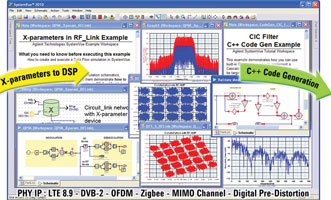

Agilent Technologies’ new release of SystemVue software generates C++ code and supports X-parameter models for connecting communications system-level design to baseband DSP and RF design flows. SystemVue 2010.01 also includes 4G applications for digital pre-distortion and MIMO channel modelling, as well as updates to its LTE, DVB-2, OFDM and ZigBee reference libraries.
The latest version introduces a new export capability for C++ source code generation and dynamic linked library (DLL) models. With this capability, SystemVue connects to virtual verification platforms and mainstream hardware design flows, even if those platforms lack a specific focus on communications and signal processing. The export capability is also included in the new W1718 C++ code generator.
Designers can generate compiled .dll libraries that add custom physical layer (PHY) communications models to other development environments and for verification of RF component designs using ADS Ptolemy. Export of compiled models is free of charge with the W1461 SystemVue base platform.
SystemVue 2010.01’s system-level support for X-parameter models brings modelling convenience, RF simulation speed and RF accuracy to baseband DSP developers and system-level architects. By offering this support, Agilent has abstracted X-parameters as a design flow bridge between wireless component designers and baseband developers looking for a better way to co-design and co-verify during their design process. The models are available as a free upgrade to owners of the W1719 RF system design kit, which adds a dedicated RF capability to the main SystemVue platform.
New application and reference libraries include:
* W1715 MIMO channel builder, which combines 4G standard WINNER-II fading models with EM propagation patterns for accurate, predictive MIMO performance.
* W1716 digital pre-distortion builder, a power amplifier linearisation and modelling utility for 4G components.
* OFDM and ZigBee PHY reference libraries, included free of charge with the W1461 SystemVue base platform.
* W1910 LTE baseband verification library, offering an LTE reference blockset with closed-loop HARQ throughput simulations.
* W1912 LTE baseband exploration library, which offers a source code version of the W1910 LTE library.
* W1914 DVB-2 baseband verification library, including DVB-S2 and DVB-T2 reference blocks for link-level studies and receiver design.
For more information contact Andrew Hutton, RF Design, +27 (0)21 555 8400, [email protected], www.rfdesign.co.za
| Tel: | +27 21 555 8400 |
| Email: | [email protected] |
| www: | www.rfdesign.co.za |
| Articles: | More information and articles about RF Design |

© Technews Publishing (Pty) Ltd | All Rights Reserved